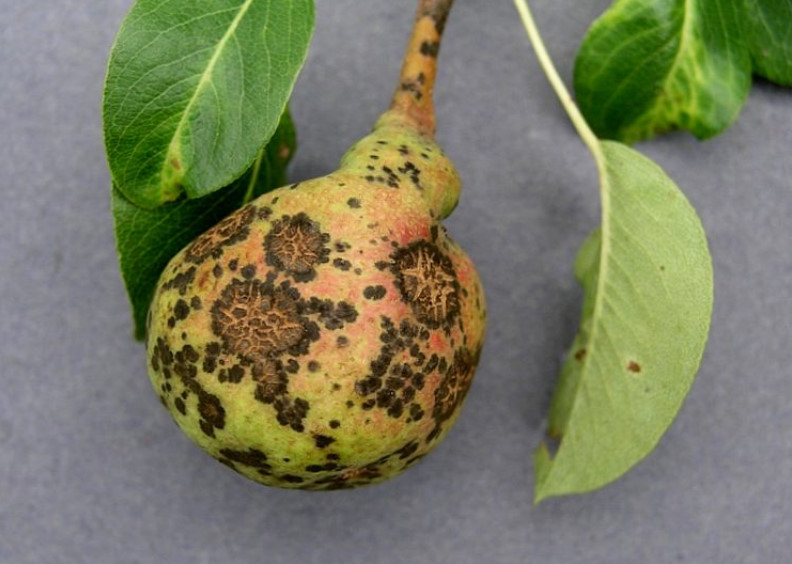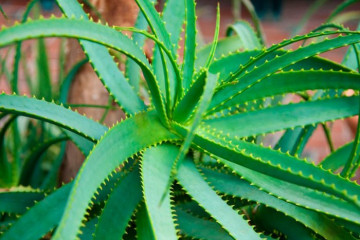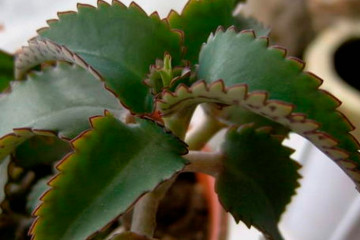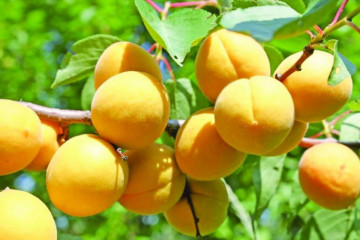Diseases of a pear: a description of diseases, how to treat brown spots on the leaves
Content:
Unfortunately, the pear, like any other plant, is susceptible to various diseases. There are many types of pathologies that differ in signs and methods of treatment. Diseases of the pear can affect the leaves, trunk, root system and fruits. Various organisms are capable of causing them. It is best to study the description of pear diseases in advance and try to prevent them.
Leaf disease symptoms and control measures
You can often see pathological processes that occur on the leaves of a pear. There are several common diseases.
Pear leaf rust (Latin Gymnosporangium sabinae)
The appearance of rust on the leaves of the culture is provoked by a fungus belonging to the Pucciniaceae family. As a result of the defeat at the first stage, small yellow spots can be seen on the foliage. After a while, they become darker and begin to resemble rust.
As a rule, the disease occurs in the spring - April or May. In the affected leaves, vital processes are disrupted, which negatively affects the general state of culture. In the future, the fruits are affected.
To prevent the spread of the disease, it is recommended to remove diseased leaves and burn them. At the beginning of the spring season, the crop should be sprayed with Bordeaux liquid. Before the winter period, it is recommended to treat the crown and trunk circle with a solution of "Carbamide". For prevention and treatment, it is allowed to use various fungicides.
White spot (septoria)
White spot also refers to diseases that are caused by fungi. This pathology leads to the weakening of the plant. As a result, the leaves fly off much earlier, and the culture does not tolerate frost well and may die. In the spring, shoots develop worse.
You can cope with a dangerous disease with the help of special fungicidal preparations. It is recommended to carry out several treatments - before the appearance of buds, after the growth of foliage, after the end of flowering. However, it is important to monitor the culture in order to identify in time what the pear is sick with and, if necessary, repeat the treatment with fungicides.
Powdery mildew (lat.Podosphaera leucotricha)
Powdery mildew is provoked by a fungus, the spores of which can be found on the leaves during examination. Initially, a white bloom appears on the upper part of the leaves, gradually it acquires an orange tint. The disease can spread to the entire tree, the affected areas dry up over time and disappear. Young twigs are most affected.
Treatment and prevention should be carried out using special fungicidal agents. However, if desired, you can use folk methods, including the use of soda, liquid soap, potassium permanganate.
Chlorosis
Chlorosis manifests itself as problems with leaves - first at the edges of the shoots, then on all branches completely. Young plates turn yellow, after which they dry out and fall off with a tail. In advanced cases, branches also suffer.
The causes of this disease are a lack of water, iron salts and other trace elements. Treatment is carried out by spraying with a solution of ferrous sulfate, if necessary, they also treat the soil around the tree. For this purpose, you can use the drug "Antichlorosin".
Brown leaf spot (phyllostictosis)
Often, finding red and brown spots on the leaves of a pear, what it is and how to treat it is not known to everyone. Most likely, this is the brown spot of the pear - phyllostictosis, which develops as a result of the defeat of the culture by the fungus. You can see brown spots on the leaves of the pear - round or indefinite. They increase as the disease spreads and can merge into one large one. At the same time, the leaves gradually fall off, the whole tree suffers - it does not tolerate frost well, does not build up the bark.
For treatment, a solution of Bordeaux liquid is used, various fungicidal preparations give a good result.
Diseases of the trunk and roots of a pear and treatment
Various diseases can affect not only the leaves. Often, the trunk and even the root system suffer from pathological processes:
- Cytosporosis or stem rot on the pear. The disease is manifested by the rapid drying of the bark, a change in its color and the appearance of gray bulges, where the fungus develops. When a branch is damaged, the leaves dry out and fall off, and the infection remains in the bark. Unfortunately, coping with the disease is not easy, so it is important to follow the rules of care and carry out preventive treatments with Bordeaux liquid.
- Black pear cancer (Latin Sphaeropsis malorum Peck). This is a rather dangerous and serious disease caused by bacteria, the spores of which can persist for several years in the cortex. All parts of the tree suffer from cancer (also called "Antonov fire"). The bark at the site of the lesion turns black, cracks, becomes stained. If untreated, the culture dies in 3-4 years. In the early stages, you can save the plant by removing the affected parts and treating the bark with a solution of copper sulfate. After processing, a garden var is applied.
- Bacterial burn. The disease manifests itself in the spring. In this case, the development of the buds slows down, the leaves gradually dry out and become black, but they remain on the branches. After some time, the trunk turns black, spots appear. Later, the bark begins to peel off in layers and become covered with ulcers. Unfortunately, it will not be possible to cope with such a disease if the trunk is damaged; it is necessary to dig up the plant and get rid of it. At the initial stage, you can try to treat the culture with streptomycin.
- Furrowing of wood. Most often, two- and three-year-old plants suffer from the disease. Cracks appear on the bark, through which bacteria penetrate. As a result, there is a violation of the exchange of nutrients between the lower and upper parts, the plant gradually dies. The only way to fight the disease is to completely destroy the tree.
- Bacterial root cancer. When infected, soft spots and pimples, bubbles form on the roots. After a while, they become larger and harden. In the initial stages, the smooth surface gradually becomes bumpy. After some time, the death of the root system occurs. The bacteria live in the soil for a couple of years and infect young trees and seedlings.
Signs and treatments for fetal diseases
On the pear, fruits can suffer from diseases.
To get a good harvest, it is recommended to know exactly about possible problems and try to prevent them:
- Scab on pear leaves and fruits. The disease is caused by a fungus, more often it manifests itself in high humidity. Dark bulging growths appear on fruits and other parts of the culture. Treatment is carried out using products containing copper.
- Gray rot is a disease of the fruit of the pear tree. At the initial stage, a small rotten spot may appear on the fruit, which gradually increases in size. After some time, small spore formations begin to appear (sometimes just white dots). As a result, the fruit rots and falls off. For treatment, a solution of Bordeaux fluid is used.
- Sooty fungus (lat.Fumago vagans Pers). In case of illness, a black bloom resembling soot can be seen on the leaves and fruits. Disease spores can survive even in winter conditions. It is recommended to treat the pear with fungicides or the "Calypso" preparation for soot fungus on the pear.
- Pear moth. Pathology develops as a result of damage to fruits by insects - a dangerous butterfly. The caterpillar gets inside the fruit, feeds only on seeds. The fetus may look normal, but inside it is all over. As a result, pears rot and fall off. It is recommended to remove dead bark, in the cracks of which the larvae of this pest often hibernate.
- Stony pear fruit. A specific virus provokes the disease. As a result, seals are formed in the fruit, which consist of tasteless cells. The fruit does not grow to the correct size. It is almost impossible to cure, you can only get rid of the plant completely.
Wood pests and their destruction
Unfortunately, in addition to diseases, pears are often affected by harmful insects:
- Hawthorn butterfly. Destroys leaves, flowers and buds. It's better to get rid of it in autumn - it's easier to find insect colonies.
- Pear mite (gallic). It settles in the buds, the larvae suck the juice from the young leaves. The metabolism of the culture is disturbed, it grows poorly and bears fruit.
- Green apple aphid. It multiplies very quickly. All parts of the tree are ill, young branches may simply die. The pest is also a carrier of various fungi and bacteria.
- Pear honeydew (leaf beetle). A dangerous insect that sucks the juice from the leaves. The tree gradually ceases to develop and bear fruit normally, and gradually dies.
- Leaf roll. This is a species of aphid that poses a serious threat. The insect is capable of destroying the entire crop and provoking the death of the plant.
Diseases and pests of pear require special attention, otherwise you can lose the culture.
Preventive measures
Prevention is the regular treatment of trees with special preparations. It is recommended to periodically inspect the culture and take the necessary measures in time. If you cannot save the pear, then it is better to simply destroy it so that the diseases do not spread to other plants.
Diseases of pears are easier to prevent than to cure. All parts of a culture can suffer, so it is important to pay attention to the appearance of various suspicious signs. For treatment, you can use both chemicals and folk remedies. Plants are sick both in the Moscow region and in other regions.






















